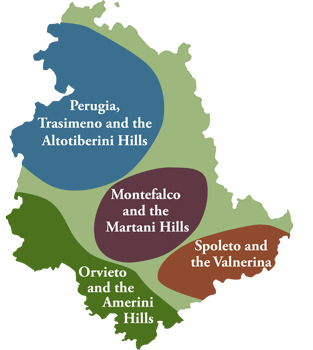
An overview of the region of Umbria, Italy


Surface area: 8456 Kmq
Population: 815.000 ca.
Provinces: Perugia (capital), Terni
Principal Cities: Assisi, Orvieto, Città di Castello, Foligno, Spoleto, Gubbio.
Average regional temperatures: January 4-5 °C – July 25-26 °C
With a population of less than one million inhabitants, Umbria is the “Green Heart of Italy” perfectly placed in the center of the nation, which offers a variety of tourist attractions. Umbria is a region dominated by hills, with altitudes that are on average between 300 and 500 meters above sea level. This geological characteristic lends itself to the cultivation of agricultural products such as olives and grapes which prefer this type of terrain. The eastern side of the region (which borders with the Marche region) is the area of Umbria-Marche Apennines, it is the highest area, where the hills give way to mountainous landscape. Monte Vettore is located in this area, its summit is 2,478 meters above sea level, making it the highest peak in the region. Other prominent mountains are the Subasio near Assisi, Monte Nerone in Città di Castello, and Monte Cucco more than 1,500 meters. Another mountain range about a thousand meters high is Martani, which lies north of Terni in the center of the region.

The territory of some of these mountains are associated with large areas of natural green areas and parks: the largest is close to the Vettore and is the National Park Parco dei Monti Sibillini. Where the village of Norcia and also the charming village of Castelluccio di Norcia are loacted, also known as the “Tetto dell’Umbria” (Roof of Umbria), 1,492 meters above sea level it is the highest town in the region. Other parks that are of interest to tourists at the foot of Monte Cucco near Gubbio (also appreciated for sports and caving). Monte Subasio with many nature trails, one of the marshes of Colfiorito, that the Tiber River near Todi and Orvieto, and the Trasimeno Lake. The Trasimeno lake, the largest in the region and one of the largest in Italy. It is a popular tourist destination with pretty villages that surround it, the islands Polvese and Major which can be visited on boat trips. Other lakes in the region are Piediluco and San Liberato near Terni, and Corbara which dips into the Tiber River Park. The Corbara lake between Todi and Orvieto, is created by the damming of the river Tiber. This river runs through the entire region from north to south through several towns, and before arriving in the Lazio region, just south of Corbara, another barrier creates WWF Natural Oasis of Alviano, a protected area of restocking several species of water birds that can be seen by special observation points.
In addition to the Tiber River, other rivers of importance are the Paglia and Chiani near Orvieto, Sand Martin in Foligno, the Velino and Nera in the Terni area. Just outside this capital city of the province with a “jump” of nearly 150 meters, the Velino waterfall which generates the great attraction “Cascate delle Marmore.”
Umbria, is not just a region rich in nature, in fact, has a good number of cities with a substantial artistic and historical heritage. From Assisi, whose impressive basilica of San Francesco is located “World Heritage” Unesco, the beautiful Perugia, and Orvieto with its magnificent cathedral and the great testimonies of the Etruscan civilization, and Spoleto with the impressive fortress Albornoz, Gubbio with its medieval charm. All this not counting the presence of many villages in the territory indicated in the guide of “the most beautiful in Italy” (the region counts over 21) including Castiglione del Lago, Norcia, Massa Martana, Montefalco, Spello, San Gemini, Bevagna, Assisi, Torgiano.
The history and tradition of Umbria are also reflected in the local handicrafts which is enhanced in the artistic production of ceramics (well represented by that famous Deruta and Orvieto, of which there are traces date from the Etruscan civilization through the Middle Ages and the modern era), and to a lesser extent in terracotta. Other prominent areas are the crafts of the artistic working of wood and leather, and of the ancient technique of lace-making in Ireland and tulle (especially in Orvieto and Panicale).

The same attachment to traditions and history is retrievable in Umbrian cuisine with a variety of original recipes and typical gastronomic products of excellence such as legumes (lentils of Castelluccio, Fava cottora of Amelia, Fagiolina del Trasimeno) and other products grown (Saffron Cascia, black celery of Trevi) and earth (black truffle Norcia). In terms of agriculture to mention that the main agricultural production is concentrated in the production of olive trees, vine, tobacco, cereals and wheat. In particular, the olive and the vine are the basis of good Umbrian table with the presence of exquisite extra virgin olive oil DOP and renowned and respected wines impossible not to mention the quality of the meat (especially poultry, sheep, goats and pigs) prepared in several ways. In particular, the pig and the skillful workmanship better known as art “norcina” is characteristic of some areas and widespread throughout the region.
MAIN TRAVEL ROUTES
The main connecting roads through the region of Umbria are the E45 which crosses vertically passing through Terni, Todi, Perugia, and up to Città di Castello, and the Autostrada A1 with toll access points in Orvieto, Orte and Fabro.
The main train stations are located in Orvieto, Perugia, Terni, Foligno. The regional airport is Saint Egidio, Perugia.
 Wine Production
Wine Production Wine Tastings
Wine Tastings Restaurant
Restaurant Wine Retail
Wine Retail Products Retail
Products Retail Bio Production
Bio Production Beer Production
Beer Production